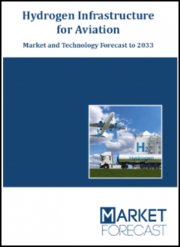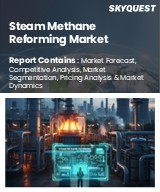
|
시장보고서
상품코드
1720933
세계의 항공용 수소 인프라 : 시장 및 기술 예측(-2033년)Hydrogen Infrastructure for Aviation - Market and Technology Forecast to 2033 |
||||||
항공 산업은 환경 부하를 줄여야 한다는 압박을 받고 있으며, 수소는 지속가능한 비행을 실현할 수 있는 유망한 기술로 주목받고 있습니다. 본 보고서는 2033년까지의 항공 분야 수소 인프라 시장 및 기술 예측을 제공합니다. 수소의 생산, 저장, 운송, 보급 등 가치사슬 전반에 걸쳐 기술 혁신이 빠르게 진행되고 있습니다. 단거리 수소 항공기는 2035년까지 운영될 수 있습니다. 각국 정부와 규제 당국은 항공 분야에서의 수소 도입을 촉진하기 위해 다양한 정책과 지원책을 강화하고 있습니다. 많은 가능성이 있는 반면, 기술 개발, 인프라 구축, 비용 절감 등의 측면에서 여전히 큰 과제가 남아있습니다.
항공을 포함한 모든 분야에서 탈탄소화가 시급한 배경에는 환경 건전성에 대한 우려 증가와 전 지구적 기후 목표를 달성해야 할 필요성이 있습니다. 국제항공운송협회(IATA)는 2050년까지 항공 업무에서 이산화탄소 배출량을 제로로 만들겠다고 선언한 바 있습니다. 수소는 항공 분야에서 유력한 대체 연료로 주목받고 있으며, 항공기 운항에서 직접적으로 탄소 배출을 제로화할 수 있는 잠재력을 가지고 있습니다. 수소의 가장 큰 장점은 질량당 에너지 비율이 높다는 점이며, 이는 특히 항공우주 분야에 유리합니다.
최근 기술 혁신으로는 2024년 3월 미국 국립재생에너지연구소(NREL)가 연료전지의 출력 밀도를 20% 향상시켜 여객기용으로 적합성을 높였고, 2024년 6월에는 에어버스와 주요 연료전지 제조업체가 코팅 및 막 기술을 개선하여 연료전지의 수명을 크게 늘린 시제품을 발표했습니다. 연료전지의 수명을 크게 늘린 프로토타입을 발표했습니다. 협력적 노력도 탄력을 받고 있습니다.
게재 기업
|
|
세계의 항공용 수소 인프라 시장과 기술에 대해 조사했으며, 기술 개요와 기술 로드맵, 시장 영향요인 분석, 시장 규모 추이와 예측, 각종 부문별/지역별/주요 국가별 상세 분석, 경쟁 구도, 주요 기업 개요 등의 정보를 정리하여 전해드립니다.
목차
제1장 주요 요약
제2장 서론
제3장 기술과 개발
- 기술 개요
- 기술 유형
- 극저온 기술의 역할
- 수소 항공기 설계와 인프라 요건
제4장 중요 원재료
제5장 시장 개요
- 서론
- 현재 시장 개요
- 현재 시장 규모와 성장 예측
- 리스크 평가
- 연구개발
- 미국
- EU
- 아시아태평양
- 투자 요건
- 사업 개발 매니저용 시장 평가
- 정부 및 민간 바이어용 시장 평가
- 예측 기간중 지역별 분포
- 주요시 기업 개요
- 주력 제품
- 최근 계약 개요
- 주요 고객 개요
- 공급망 개요
제6장 시장 역학과 예측 요인
- 시장 세분화
- 성장 촉진요인
- 동향
- 기회
- 과제
- 예측 요인과 시장에 대한 영향
- 기본 시나리오
- 성장 시나리오
제7장 국가별 분석
- 개요
- 북미 국가
- 유럽 국가
- 아시아태평양 국가
- 라틴아메리카 국가
- 중동 및 아프리카 국가
제8장 항공용 수소 인프라 시장 : 지역별
- 개요 : 지역별
- 개요 : 인프라 컴포넌트별
- 북미
- 유럽
- 아시아태평양
- 중동 및 아프리카
- 이라텐아메리카
제9장 항공용 수소 인프라 시장 : 인프라 컴포넌트별
- 개요 : 인프라 컴포넌트별
- 개요 : 지역별
- 생산
- 저장
- 운송
- 공항 유통
제10장 성장 시나리오
- 성장 시나리오
- 개요 : 지역별
- 개요 : 인프라 컴포넌트별
제11장 주요 기업
- Airbus SE(Group)
- Blue Spirit Aero
- China Aviation Oil(Singapore) Corporation Ltd
- Dassault Aviation
- Embraer
- Joby Aviation
- MTU Aero Engines AG
- Safran S.A.
- The Boeing Company
- Topsoe
- TotalEnergies
- ZeroAvia
- 기타 흥미로운 기업
- Everfuel Galp Energia GreenSinnergy Norwegian Hydrogen Saudi Aramco Verbund
제12장 조사 결과 및 결론
제13장 시장 예측에 대해
부록 A : 언급된 기업
부록 B : 약어
LSH 25.05.26Market forecasts by Region and Infrastructure Components. Technologies and Market Overview, Country Analysis, Growth Scenario, and Leading Companies
The aviation industry faces increasing pressure to reduce its environmental impact, and hydrogen has emerged as a promising technology to achieve sustainable flight. This report provides a market and technology forecast for hydrogen infrastructure in aviation up to 2033. Technological advancements are rapidly occurring across the hydrogen value chain, from production and storage to transportation and refuelling. Short-range hydrogen-powered aircraft could potentially enter service by 2035. Governments and regulatory bodies are increasingly providing support through initiatives and policies to drive the adoption of hydrogen in aviation. Despite the considerable opportunities, significant challenges remain in terms of technological development, infrastructure build-out, and cost reduction.
The urgent need for decarbonization across all sectors, including aviation, is driven by growing concerns about environmental health and the imperative to meet global climate goals. The International Air Transport Association (IATA) has committed to achieving net-zero carbon emissions from their operations by 2050. Hydrogen stands out as a compelling alternative fuel for aviation, offering the potential for zero direct carbon emissions from aircraft operations. A key advantage of hydrogen is its high energy-to-mass ratio, which is particularly beneficial for aerospace applications. Recent innovations include the National Renewable Energy Laboratory's (NREL) achievement in increasing fuel cell power density by 20% in March 2024, enhancing their suitability for passenger aircraft. In June 2024, Airbus and a leading fuel cell manufacturer unveiled a prototype with improved coatings and membrane technologies, significantly extending fuel cell lifespan. Collaborative efforts are also gaining momentum.
In response to the escalating demand for hydrogen in aviation, Amsterdam-based Market Forecast has published a comprehensive report, "Hydrogen Infrastructure for Aviation - Market and Technology Forecast to 2033." This study aims to provide readers with an in-depth understanding of the latest developments within this rapidly evolving sector, encompassing both market trends and technological advancements crucial for the implementation of hydrogen-powered aircraft.
Covered in this study:
- Market forecasts: Detailed market size projections for each Hydrogen Infrastructure for Aviation type from 2025 to 2033, segmented by Region, Type, Application and End User
- Technology Roadmaps: In-depth analysis of the technological evolution, challenges, and breakthroughs anticipated for each Hydrogen Infrastructure for Aviation applications.
- Procurement Insights: Examination of procurement strategies, trends, and forecasts for both commercial sectors
- Regional Analysis:Uncovering region-specific regulatory environments, infrastructure development, and market opportunities
- Competitive Landscape: Overview of key players, innovators, and new entrants shaping the future of Hydrogen Infrastructure for Aviation
Segmentation
The market is segmented in regions and Infrastructure Components.
Region
- North America
- Europe
- Asia-Pacific
- Middle East and Africa
- Latin America
Infrastructure Components
- Production
- Storage
- Transportation
- Airport Distribution
Reasons to buy:
- Determine prospective investment areas based on a detailed trend analysis of the global Hydrogen Infrastructure for Aviation Market over the next eight years.
- Gain in-depth understanding about the underlying factors driving demand for different systems segments in the top spending countries across the world and identify the opportunities offered by each of them
- Strengthen your understanding of the market in terms of demand drivers, industry trends, and the latest technological developments, among others
- Identify the major channels that are driving the global Hydrogen Infrastructure for Aviation business, providing a clear picture about future opportunities that can be tapped, resulting in revenue expansion
- Channelize resources by focusing on the ongoing programs that are being undertaken by the ministries of different countries within the Hydrogen Infrastructure for Aviation Market
- Make correct business decisions based on thorough analysis of the total competitive landscape of the sector with detailed profiles of the top systems providers around the world which include information about their products, alliances, recent contract wins and financial analysis wherever available
Companies Listed:
|
|
Table of Contents
1. Executive Summary
- 1.1. Trends and Insights
- 1.2. Main Findings
- 1.2.1. Hydrogen Infrastructure for Aviation market summary by Region
- 1.2.2. Hydrogen Infrastructure for Aviation market summary by Infrastructure Components
- 1.3. Key Conclusions
2. Introduction
- 2.1. Scope
- 2.2. Methodology
- 2.2.1. Data Collection and Sources
- 2.2.2. Market Forecasting Model
- 2.2.3. Hydrogen Transportation Cost Calculation
- 2.2.4. Infrastructure Development and Deployment Modelling
- 2.2.5. Validation and Cross-Verification
- 2.3. Who will benefit from this study?
3. Technologies and Developments
- 3.1. Technology overview
- 3.2. Types of Technologies
- 3.2.1. Role of Cryogenic Technology
- 3.2.2. Hydrogen Aircraft Design And Infrastructure Requirements
4. Critical Raw Materials
5. Market Overview
- 5.1. Introduction
- 5.2. Current Market Overview
- 5.2.1. Global aviation industry's current energy consumption patterns and carbon footprint
- 5.2.2. Existing hydrogen infrastructure landscape in aviation
- 5.2.3. Regional market variations and regulatory frameworks affecting hydrogen adoption
- 5.2.4. Regional market variations and regulatory frameworks affecting hydrogen adoption
- 5.3. Current Market Size and Growth Projections
- 5.4. Risk Assessment
- 5.5. Research and Development
- 5.5.1. Research and Development in the US
- 5.5.2. Research and Development in the European Union
- 5.5.3. Research and Development in the Asia-Pacific
- 5.6. Investment Requirements
- 5.7. Market Assessment for Business Development Managers
- 5.8. Market Assessment for Government and Commercial Buyers
- 5.9. Hydrogen Infrastructure for Aviation market volume distribution over forecast period by Region
- 5.9.1. Main Market Players Overview
- 5.9.2. Leading Products
- 5.9.3. Recent Contracts Overview
- 5.9.4. Main Customers Overview
- 5.9.5. Supply Chain Overview
6. Market Dynamics and Forecast Factors
- 6.1. Market Segmentation
- 6.2. Drivers
- 6.3. Trends
- 6.4. Opportunities
- 6.5. Challenges
- 6.6. Forecast factors and Market Impact
- 6.6.1. Base Scenario
- 6.6.2. Growth Scenario
7. Country Analysis
- 7.1. Overview
- 7.2. Countries in North America
- 7.3. Countries in Europe
- 7.4. Countries in Asia Pacific
- 7.5. Countries in Latin America
- 7.6. Countries in Middle East and Africa
8. Hydrogen Infrastructure for Aviation market to 2033 by Region
- 8.1. Hydrogen Infrastructure for Aviation market by Region overview
- 8.2. Hydrogen Infrastructure for Aviation market Region by Infrastructure Components overview
- 8.2.1. North America market by Infrastructure Components overview
- 8.2.2. Europe market by Infrastructure Components overview
- 8.2.3. Asia-Pacific market by Infrastructure Components overview
- 8.2.4. Middle-East & Africa market by Infrastructure Components overview
- 8.2.5. Latin America market by Infrastructure Components overview
9. Hydrogen Infrastructure for Aviation market to 2033 by Infrastructure Components
- 9.1. Hydrogen Infrastructure for Aviation market by Infrastructure Components overview
- 9.2. Hydrogen Infrastructure for Aviation market Infrastructure Components by Region overview
- 9.2.1. Market by Region overview
- 9.2.2. Market by Region overview
- 9.2.3. Storage market by Region overview
- 9.2.4. Market by Region overview
10. Growth Scenario
- 10.1. Growth Scenario
- 10.1.1. Hydrogen Infrastructure for Aviation market summary by Region
- 10.1.2. Hydrogen Infrastructure for Aviation market summary by Infrastructure Components
11. Leading Companies
- 11.1. Airbus SE (Group)
- 11.1.1. Introduction
- 11.1.2. Products and Services
- 11.1.3. Recent Contracts and Developments
- 11.1.4. SWOT Analysis
- 11.2. Blue Spirit Aero
- 11.2.1. Introduction
- 11.2.2. Products and Services
- 11.2.3. Recent Contracts and Developments
- 11.2.4. SWOT Analysis
- 11.3. China Aviation Oil (Singapore) Corporation Ltd
- 11.3.1. Introduction
- 11.3.2. Products and Services
- 11.3.3. Recent Contracts and Developments
- 11.3.4. SWOT Analysis
- 11.4. Dassault Aviation
- 11.4.1. Introduction
- 11.4.2. Products and Services
- 11.4.3. Recent Contracts and Developments
- 11.4.4. SWOT Analysis
- 11.5. Embraer
- 11.5.1. Introduction
- 11.5.2. Products and Services
- 11.5.3. Recent Contracts and Developments
- 11.5.4. SWOT Analysis
- 11.6. Joby Aviation
- 11.6.1. Introduction
- 11.6.2. Products and Services
- 11.6.3. Recent Developments and Contracts
- 11.6.4. SWOT Analysis
- 11.7. MTU Aero Engines AG
- 11.7.1. Introduction
- 11.7.2. Products and Services
- 11.7.3. Recent Contracts and Developments
- 11.7.4. SWOT Analysis
- 11.8. Safran S.A.
- 11.8.1. Introduction
- 11.8.2. Products and Services
- 11.8.3. Recent Contracts and Developments
- 11.8.4. SWOT Analysis
- 11.9. The Boeing Company
- 11.9.1. Introduction
- 11.9.2. Products and Services
- 11.9.3. Recent Contracts and Developments
- 11.9.4. SWOT Analysis
- 11.10. Topsoe
- 11.10.1. Introduction
- 11.10.2. Products and Services
- 11.10.3. Recent Contracts and Developments
- 11.10.4. SWOT Analysis
- 11.11. TotalEnergies
- 11.11.1. Introduction
- 11.11.2. Products and Services
- 11.11.3. Recent Contracts and Developments
- 11.11.4. SWOT Analysis
- 11.12. ZeroAvia
- 11.12.1. Introduction
- 11.12.2. Products and Services
- 11.12.3. Recent Contracts and Developments
- 11.12.4. SWOT Analysis
- 11.13. Other companies of interest
- 11.13.1. Everfuel
- 11.13.2. Galp Energia
- 11.13.3. GreenSinnergy
- 11.13.4. Norwegian Hydrogen
- 11.13.5. Saudi Aramco
- 11.13.6. Verbund
12. Results and Conclusions
13. About Market Forecast
- 13.1. General
- 13.2. Contact us
- 13.3. Disclaimer
- 13.4. License
Appendix A: Companies Mentioned
Appendix B: Abbreviations
List of figures
- Figure 1: Hydrogen Infrastructure for Aviation market summary by Region
- Figure 2: Hydrogen Infrastructure for Aviation Size by Region
- Figure 3: Hydrogen Infrastructure for Aviation CAGR by Region in US$ millions
- Figure 4: Hydrogen Infrastructure for Aviation market summary by Infrastructure Components
- Figure 5: Hydrogen Infrastructure for Aviation Size by Infrastructure Components
- Figure 6: Hydrogen Infrastructure for Aviation CAGR by Infrastructure Components in US$ millions
- Figure 7: Critical Raw Materials producing countries
- Figure 8: Critical Raw Materials dependence [%] and volume [Mt] by producing countries
- Figure 9: Certification Readiness of the expected architectures for hydrogen on aircraft
- Figure 10: Market volume distribution over the forecast period by region
- Figure 11: LH2-ISO-Container (HYLICS)
- Figure 12: Poseidon 20MW process module
- Figure 13: Hydrogen Infrastructure for Aviation - Supply Chain Flowchart
- Figure 14: Market Segmentation and Sub Segmentation Hydrogen Infrastructure for Aviation Market
- Figure 15: Subscale Nimble Sparrow-H
- Figure 16: Liquid hydrogen test facility
- Figure 17: Hydrogen hub
- Figure 18: Hydrogen Infrastructure for Aviation market to 2033 by Region [US$ millions]
- Figure 19: Hydrogen Infrastructure for Aviation market to 2033 by Region %
- Figure 20: North America Hydrogen Infrastructure for Aviation market to 2033 by Infrastructure Components
- Figure 21: North America - Hydrogen Infrastructure for Aviation market to 2033 by Infrastructure Components
- Figure 22: Europe Hydrogen Infrastructure for Aviation market to 2033 by Infrastructure Components
- Figure 23: Europe - Hydrogen Infrastructure for Aviation market to 2033 by Infrastructure Components
- Figure 24: Asia-Pacific Hydrogen Infrastructure for Aviation market to 2033 by Infrastructure Components
- Figure 25: Asia-Pacific - Hydrogen Infrastructure for Aviation market to 2033 by Infrastructure Components
- Figure 26: Middle-East & Africa Hydrogen Infrastructure for Aviation market to 2033 by Infrastructure Components
- Figure 27: Middle-East & Africa - Hydrogen Infrastructure for Aviation market to 2033 by Infrastructure Components
- Figure 28: Latin America Hydrogen Infrastructure for Aviation market to 2033 by Infrastructure Components
- Figure 29: Latin America - Hydrogen Infrastructure for Aviation market to 2033 by Infrastructure Components
- Figure 30: Hydrogen Infrastructure for Aviation market to 2033 by Infrastructure Components [US$ millions]
- Figure 31: Hydrogen Infrastructure for Aviation market to 2033 by Infrastructure Components %
- Figure 32: Hydrogen Infrastructure for Aviation market to 2033 by Region
- Figure 33: - Hydrogen Infrastructure for Aviation market to 2033 by Region
- Figure 34: Hydrogen Infrastructure for Aviation market to 2033 by Region
- Figure 35: - Hydrogen Infrastructure for Aviation market to 2033 by Region
- Figure 36: Storage Hydrogen Infrastructure for Aviation market to 2033 by Region
- Figure 37: Storage - Hydrogen Infrastructure for Aviation market to 2033 by Region
- Figure 38: Hydrogen Infrastructure for Aviation market to 2033 by Region
- Figure 39: - Hydrogen Infrastructure for Aviation market to 2033 by Region
- Figure 40: Hydrogen Infrastructure for Aviation market summary by Region
- Figure 41: Hydrogen Infrastructure for Aviation Size by Region
- Figure 42: Hydrogen Infrastructure for Aviation CAGR by Region in US$ millions
- Figure 43: Market volumes over the forecast period per region
- Figure 44: Hydrogen Infrastructure for Aviation market summary by Infrastructure Components
- Figure 45: Hydrogen Infrastructure for Aviation Size by Infrastructure Components
- Figure 46: Hydrogen Infrastructure for Aviation CAGR by Infrastructure Components in US$ millions
List of tables
- Figure 1: Hydrogen Infrastructure for Aviation market summary by Region
- Figure 2: Hydrogen Infrastructure for Aviation Size by Region
- Figure 3: Hydrogen Infrastructure for Aviation CAGR by Region in US$ millions
- Figure 4: Hydrogen Infrastructure for Aviation market summary by Infrastructure Components
- Figure 5: Hydrogen Infrastructure for Aviation Size by Infrastructure Components
- Figure 6: Hydrogen Infrastructure for Aviation CAGR by Infrastructure Components in US$ millions
- Figure 7: Critical Raw Materials producing countries
- Figure 8: Critical Raw Materials dependence [%] and volume [Mt] by producing countries
- Figure 9: Certification Readiness of the expected architectures for hydrogen on aircraft
- Figure 10: Market volume distribution over the forecast period by region
- Figure 11: LH2-ISO-Container (HYLICS)
- Figure 12: Poseidon 20MW process module
- Figure 13: Hydrogen Infrastructure for Aviation - Supply Chain Flowchart
- Figure 14: Market Segmentation and Sub Segmentation Hydrogen Infrastructure for Aviation Market
- Figure 15: Subscale Nimble Sparrow-H
- Figure 16: Liquid hydrogen test facility
- Figure 17: Hydrogen hub
- Figure 18: Hydrogen Infrastructure for Aviation market to 2033 by Region [US$ millions]
- Figure 19: Hydrogen Infrastructure for Aviation market to 2033 by Region %
- Figure 20: North America Hydrogen Infrastructure for Aviation market to 2033 by Infrastructure Components
- Figure 21: North America - Hydrogen Infrastructure for Aviation market to 2033 by Infrastructure Components
- Figure 22: Europe Hydrogen Infrastructure for Aviation market to 2033 by Infrastructure Components
- Figure 23: Europe - Hydrogen Infrastructure for Aviation market to 2033 by Infrastructure Components
- Figure 24: Asia-Pacific Hydrogen Infrastructure for Aviation market to 2033 by Infrastructure Components
- Figure 25: Asia-Pacific - Hydrogen Infrastructure for Aviation market to 2033 by Infrastructure Components
- Figure 26: Middle-East & Africa Hydrogen Infrastructure for Aviation market to 2033 by Infrastructure Components
- Figure 27: Middle-East & Africa - Hydrogen Infrastructure for Aviation market to 2033 by Infrastructure Components
- Figure 28: Latin America Hydrogen Infrastructure for Aviation market to 2033 by Infrastructure Components
- Figure 29: Latin America - Hydrogen Infrastructure for Aviation market to 2033 by Infrastructure Components
- Figure 30: Hydrogen Infrastructure for Aviation market to 2033 by Infrastructure Components [US$ millions]
- Figure 31: Hydrogen Infrastructure for Aviation market to 2033 by Infrastructure Components %
- Figure 32: Hydrogen Infrastructure for Aviation market to 2033 by Region
- Figure 33: - Hydrogen Infrastructure for Aviation market to 2033 by Region
- Figure 34: Hydrogen Infrastructure for Aviation market to 2033 by Region
- Figure 35: - Hydrogen Infrastructure for Aviation market to 2033 by Region
- Figure 36: Storage Hydrogen Infrastructure for Aviation market to 2033 by Region
- Figure 37: Storage - Hydrogen Infrastructure for Aviation market to 2033 by Region
- Figure 38: Hydrogen Infrastructure for Aviation market to 2033 by Region
- Figure 39: - Hydrogen Infrastructure for Aviation market to 2033 by Region
- Figure 40: Hydrogen Infrastructure for Aviation market summary by Region
- Figure 41: Hydrogen Infrastructure for Aviation Size by Region
- Figure 42: Hydrogen Infrastructure for Aviation CAGR by Region in US$ millions
- Figure 43: Market volumes over the forecast period per region
- Figure 44: Hydrogen Infrastructure for Aviation market summary by Infrastructure Components
- Figure 45: Hydrogen Infrastructure for Aviation Size by Infrastructure Components
- Figure 46: Hydrogen Infrastructure for Aviation CAGR by Infrastructure Components in US$ millions



















